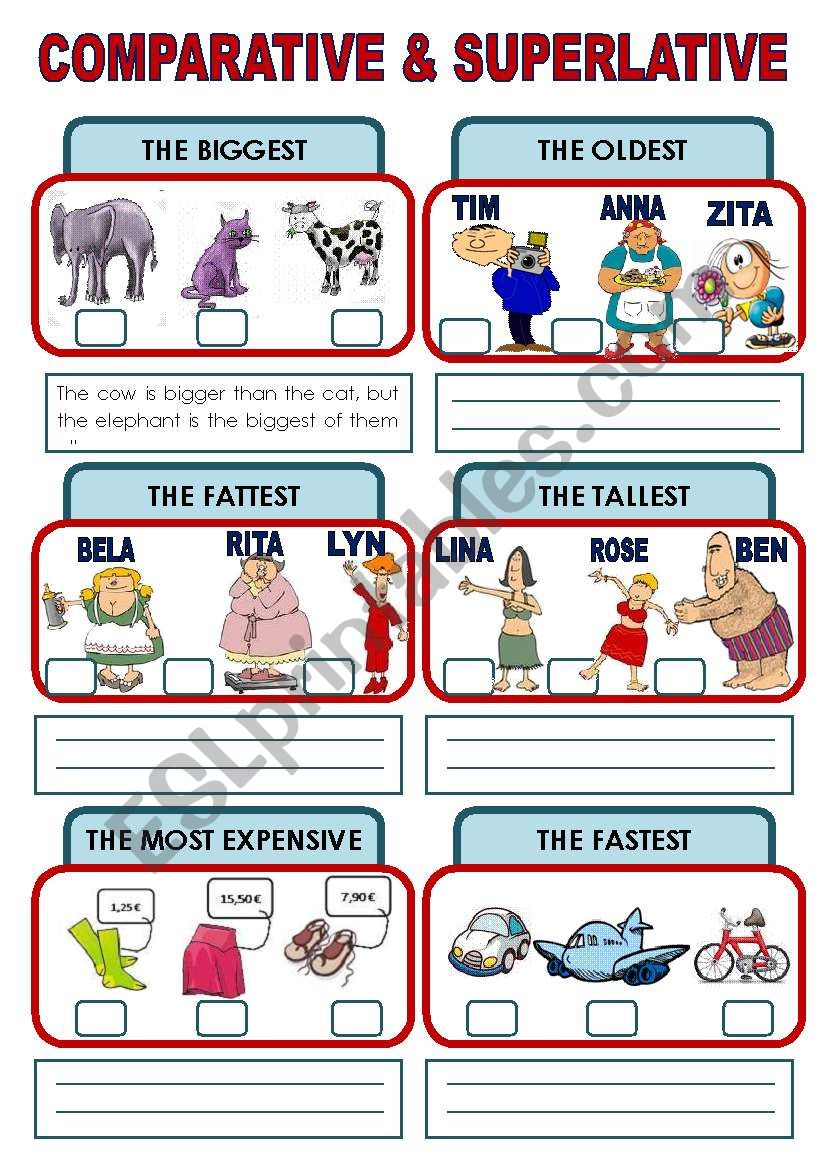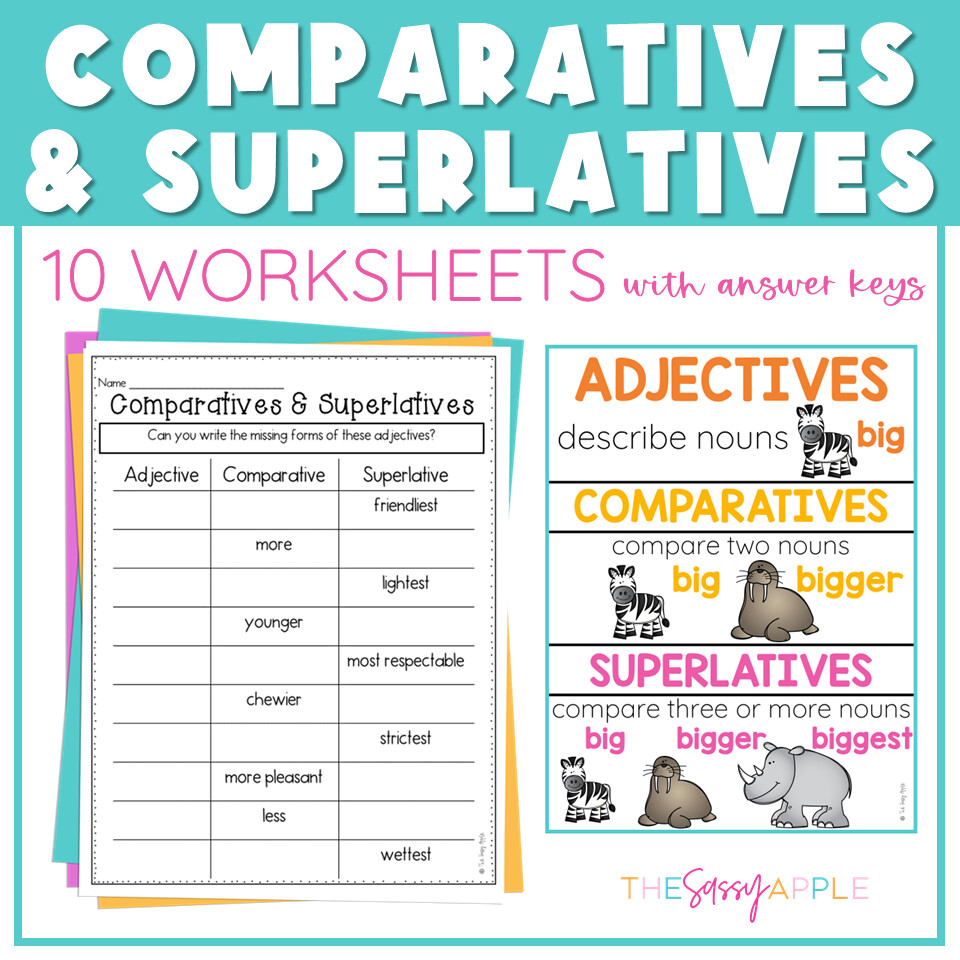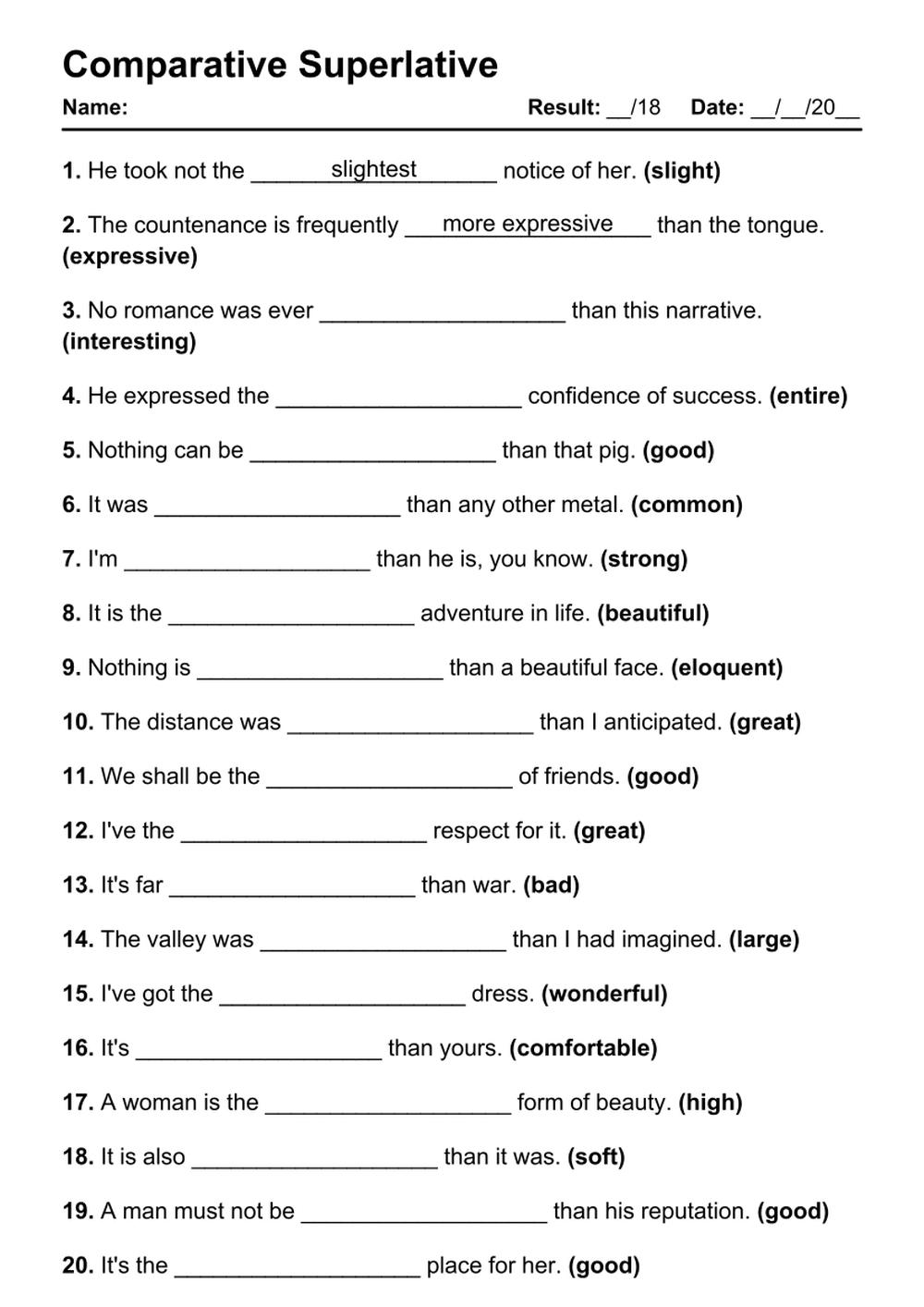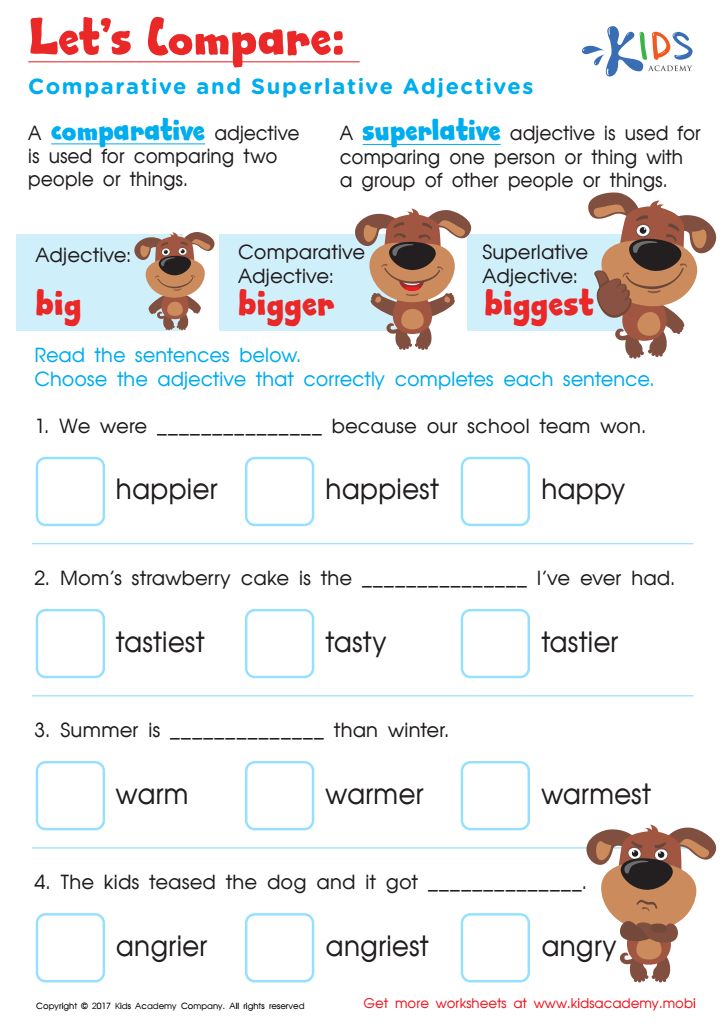
Mastering Degrees of Comparison: The Indispensable Role of Comparative and Superlative Lesson Worksheets
In the intricate tapestry of the English language, adjectives and adverbs serve as vibrant threads, adding color, detail, and nuance to our communication. They allow us to describe, qualify, and compare, making our expressions richer and more precise. Among the most fundamental aspects of mastering these descriptive words is understanding and correctly using their comparative and superlative forms. These grammatical structures enable us to express degrees of difference and extreme qualities, moving beyond simple descriptions to make sophisticated comparisons. For language learners, grasping these concepts can be a significant hurdle, requiring consistent practice and clear reinforcement. This is precisely where comparative and superlative lesson worksheets emerge as an invaluable pedagogical tool, offering structured, repetitive, and varied exercises essential for solidifying understanding and building fluency.
The Core Concepts: Comparatives and Superlatives Revisited

Before delving into the utility of worksheets, it’s crucial to briefly revisit the core concepts themselves. Comparative forms are used to compare two things, indicating which one possesses a certain quality to a greater or lesser degree. For most short adjectives (one or two syllables), we add "-er" (e.g., taller, faster, happier). For longer adjectives (three or more syllables), we use "more" (e.g., more beautiful, more intelligent). Adverbs follow similar patterns, often using "more" (e.g., more quickly, more carefully).

Superlative forms, on the other hand, are used to compare three or more things, identifying the one that possesses the quality to the highest or lowest degree within a group. For short adjectives, we add "-est" (e.g., tallest, fastest, happiest). For longer adjectives, we use "most" (e.g., most beautiful, most intelligent). Again, adverbs generally use "most" (e.g., most quickly, most carefully). Beyond these regular forms, there are also irregular adjectives and adverbs (e.g., good/better/best, bad/worse/worst, far/further/furthest), which require rote memorization and dedicated practice.

The nuances of spelling changes (e.g., big/bigger/biggest vs. happy/happier/happiest), the use of "than" with comparatives, and "the" with superlatives, all add layers of complexity that learners must internalize. This foundational knowledge, while seemingly straightforward, demands repeated exposure and application to become second nature.

Why Worksheets? The Pedagogical Power of Structured Practice

In the realm of language acquisition, passive listening or theoretical explanations alone are rarely sufficient for true mastery. Active engagement, application, and repetition are key. This is where comparative and superlative lesson worksheets shine. They transform abstract grammatical rules into tangible tasks, allowing learners to actively construct, identify, and correct sentences using the target structures.
Here’s why worksheets are so effective:
- Reinforcement and Repetition: Language learning thrives on repetition. Worksheets provide numerous opportunities for learners to practice the same grammatical patterns in varied contexts, drilling the rules until they become automatic. This consistent exposure helps move the knowledge from short-term to long-term memory.
- Immediate Application: After a teacher explains the rules, a worksheet allows students to immediately apply what they’ve learned. This instant application helps solidify understanding and identify any areas of confusion before misconceptions become ingrained.
- Personalized Pace: Unlike group activities, worksheets allow students to work at their own speed. Faster learners can move ahead, while those who need more time can take it without feeling rushed or holding back the class. This individual pacing caters to diverse learning styles and abilities.
- Error Identification and Correction: Worksheets provide a structured environment for students (or teachers) to identify errors. With an answer key, students can self-correct, fostering independent learning and metacognitive skills. For teachers, completed worksheets offer valuable diagnostic information about common errors.
- Focus on Form and Accuracy: While communicative activities are vital for fluency, worksheets provide a dedicated space to focus on grammatical accuracy. They ensure that learners are not just conveying meaning, but doing so correctly according to the rules of English.



Diverse Types of Comparative and Superlative Lesson Worksheets
The beauty of comparative and superlative lesson worksheets lies in their versatility. They can be designed to target different skills and address various learning stages. Some common types include:

- Fill-in-the-Blanks: Students complete sentences by inserting the correct comparative or superlative form of a given adjective/adverb. (e.g., "Mount Everest is the ____ (high) mountain in the world.")
- Sentence Transformation: Students rewrite sentences, changing positive statements into comparative or superlative ones. (e.g., "The blue car is fast. -> The red car is ____ (fast) than the blue car.")
- Error Correction: Students identify and correct grammatical mistakes in sentences that contain incorrect comparative or superlative forms. This higher-order thinking task hones their analytical skills.
- Picture-Based Activities: Worksheets use images to prompt comparisons and superlatives, making the learning visual and engaging, especially for younger learners or visual learners. (e.g., "Look at the three animals. Which one is the ____ (big)?")
- Dialogue Completion/Creation: Students complete or create short dialogues using comparative and superlative forms in a communicative context. This bridges the gap between mechanical practice and real-world application.
- Opinion/Preference Prompts: Students use comparatives and superlatives to express their opinions or preferences about various topics, encouraging more personal and meaningful use of the language. (e.g., "Which season is the ____ (good) for outdoor activities?")
- Reading Comprehension with Targeted Grammar: Short texts are provided, followed by questions that require students to extract information using comparative or superlative forms, or to analyze the use of these forms within the text.
The variety ensures that learning remains dynamic and prevents monotony, keeping students engaged while reinforcing the target grammar points from multiple angles.
Designing Effective Comparative and Superlative Lesson Worksheets
Creating high-quality comparative and superlative lesson worksheets is an art that blends pedagogical principles with clear design. Effective worksheets are:
- Clear and Concise: Instructions should be easy to understand, even for learners with limited English proficiency.
- Graduated in Difficulty: Start with simpler tasks (e.g., regular forms, fill-in-the-blanks) and gradually introduce more complex ones (e.g., irregular forms, error correction, creative writing). This scaffolding builds confidence and prevents overwhelm.
- Contextualized: Whenever possible, exercises should be based on relevant and relatable topics. Comparing animals, cities, hobbies, or famous people makes the content more engaging and meaningful than isolated sentences.
- Visually Appealing: Clean layouts, appropriate use of white space, and relevant illustrations or graphics can significantly enhance engagement and readability.
- Equipped with Answer Keys: For self-correction or efficient teacher grading, a clear answer key is crucial.
- Differentiated: Consider including sections for different proficiency levels within a single worksheet or creating different versions to cater to varied needs within a classroom.
Integrating Worksheets into a Broader Lesson Plan
While powerful, worksheets are most effective when integrated thoughtfully into a comprehensive lesson plan. They are not standalone activities but components of a larger learning cycle. A typical flow might look like this:
- Introduction/Explanation: The teacher introduces or reviews the rules of comparatives and superlatives using a whiteboard, presentation, or interactive discussion.
- Guided Practice (Worksheet 1): The class works through the first few exercises of a worksheet together, allowing the teacher to model the process and clarify immediate questions.
- Independent Practice (Worksheet 2): Students then complete the remainder of the worksheet individually or in pairs, applying the rules on their own. This is where the true power of comparative and superlative lesson worksheets for individual reinforcement comes into play.
- Review and Feedback: The teacher reviews answers, addresses common mistakes, and provides constructive feedback.
- Communicative Activities: Following the worksheet practice, the lesson transitions to speaking or writing activities that encourage students to use comparatives and superlatives in more free and spontaneous ways (e.g., debates, role-plays, descriptive writing).
This systematic approach ensures that learners first understand the theory, then practice it in a controlled environment, and finally apply it in communicative contexts.
The Digital Evolution: Interactive Comparative and Superlative Lesson Worksheets
In the digital age, the concept of worksheets has evolved beyond static printouts. Interactive digital comparative and superlative lesson worksheets offer additional benefits:
- Immediate Feedback: Students receive instant feedback on their answers, allowing for real-time correction and deeper learning.
- Gamification: Many digital platforms incorporate game-like elements, leaderboards, and badges, making grammar practice more engaging and less intimidating.
- Accessibility: Digital worksheets can be accessed anywhere, anytime, on various devices, supporting remote learning or independent study.
- Automatic Grading: For teachers, digital worksheets often come with automatic grading features, saving valuable time and providing quick insights into student performance.
- Multimedia Integration: Digital versions can embed audio, video, and animations, enriching the learning experience.
Platforms like Google Forms, Liveworksheets, Quizlet, and various educational apps now offer robust tools for creating and distributing dynamic comparative and superlative lesson worksheets, catering to the tech-savvy learner and streamlining the teaching process.
Addressing Challenges and Maximizing Impact
Despite their numerous benefits, it’s important to use worksheets judiciously. Over-reliance can lead to rote memorization without true understanding or the development of communicative fluency. Teachers should aim for a balance, ensuring that worksheet practice is always complemented by speaking, listening, and writing activities that require authentic language use.
Furthermore, teachers should emphasize understanding the meaning conveyed by comparatives and superlatives, not just the mechanical application of rules. Encouraging students to create their own comparison sentences about their lives, interests, or surroundings can make the learning more personal and memorable. Peer correction and collaborative completion of worksheets can also foster a supportive learning environment and deepen understanding through discussion.
Conclusion
In conclusion, the journey to mastering the English language is multifaceted, requiring a blend of theoretical knowledge, consistent practice, and authentic application. Within this journey, the ability to express degrees of comparison is a crucial milestone. Comparative and superlative lesson worksheets stand out as an indispensable resource in this endeavor. They provide the structured, repetitive, and varied practice necessary for learners to internalize complex grammatical rules, build confidence, and ultimately achieve fluency. Whether in traditional print format or innovative digital forms, these worksheets remain a cornerstone of effective English language teaching, empowering learners to describe their world with greater precision and expressiveness. Their enduring value lies in their ability to transform abstract grammar into achievable tasks, paving the way for more sophisticated and nuanced communication.
